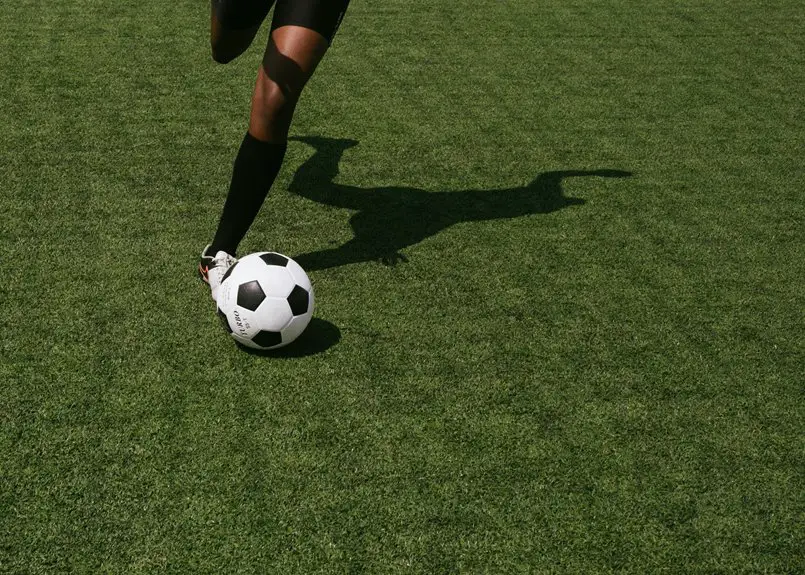To stay energized and avoid that heavy leg feeling, focus on hydration, movement breaks, and a balanced diet. Drink plenty of water, aim for nutrient-rich meals every few hours, and incorporate exercises like squats and calf raises to improve circulation. Don’t forget to elevate your legs whenever you can. Choosing the right footwear can also make a big difference. There’s plenty more you can do to enhance your energy and keep your legs feeling light.
Table of Contents
Key Takeaways
- Stay hydrated by drinking at least eight glasses of water daily to maintain energy levels and prevent feelings of heaviness in your legs.
- Incorporate nutrient-rich foods like whole grains, fruits, and healthy fats in your diet to support muscle health and energy.
- Take regular movement breaks every 30 to 60 minutes to stand, stretch, or walk, enhancing circulation and reducing fatigue.
- Engage in strengthening exercises such as squats and lunges to improve circulation and reduce muscle fatigue in your legs.
- Prioritize quality sleep by aiming for 7-9 hours and establishing a consistent sleep schedule to aid recovery and sustain energy levels.
Understand the Causes of Heavy Legs
When you experience heavy legs, it’s essential to understand what’s causing that sensation. Often, it’s linked to poor circulation or prolonged sitting, which can lead to fluid buildup.
Maybe you’ve been standing for too long, causing your muscles to tire and feel weighted down. Lack of muscle tone can also play a role; if you’re not active regularly, your legs might struggle to support you.
Additionally, factors like stress and fatigue can contribute to that sluggish feeling. Even diet can impact your energy levels; low iron or vitamin deficiencies may leave you feeling drained.
Identifying the root cause is vital for finding effective solutions and getting back to feeling light and energized.
Stay Hydrated Throughout the Day
Staying hydrated throughout the day is essential for maintaining energy levels and preventing that heavy leg sensation. When you don’t drink enough water, your body can become fatigued, leading to feelings of heaviness in your legs.
Aim to drink at least eight glasses of water daily, but adjust based on your activity level and climate. Carry a reusable water bottle with you to remind yourself to sip throughout the day. If plain water doesn’t excite you, infuse it with fruits or herbs for added flavor.
Also, consider incorporating hydrating foods like cucumbers and watermelon into your meals. By staying properly hydrated, you’ll boost your overall energy and keep that heavy leg feeling at bay!
Incorporate Regular Movement Breaks
To keep your energy up and legs light, it’s important to incorporate regular movement breaks throughout your day.
Set timers to remind yourself to stretch and move, and consider turning meetings into walking sessions.
These simple adjustments can make a big difference in how you feel.
Set Timers for Breaks
Setting timers for breaks can greatly boost your energy levels and help prevent that sluggish feeling in your legs. By incorporating short, scheduled breaks into your routine, you’ll give your body a chance to recharge and reset.
Aim for a timer that goes off every 30 to 60 minutes, reminding you to step away from your desk or work area. During these breaks, stand up, walk around, or simply shift your posture. This simple practice can enhance circulation and keep your legs feeling light and energized.
You’ll find that staying mindful of your movement helps you stay focused and productive throughout the day. So, set those timers, take a moment to breathe, and keep your energy flowing!
Stretch and Move
While you’re working, incorporating regular movement breaks is essential for keeping your energy up and preventing that heavy feeling in your legs. Just a few minutes of stretching or moving around can make a big difference.
Here are some easy ways to fit movement into your day:
- Stand up and stretch your arms and legs.
- Walk around your workspace for a minute or two.
- Do a few calf raises or squats.
- Practice neck rolls to relieve tension.
- Take deep breaths while standing to increase circulation.
These small breaks can re-energize you, boost your productivity, and help you feel lighter on your feet.
Incorporate Walking Meetings
Incorporating walking meetings into your routine can elevate your energy levels and keep that heavy leg sensation at bay. Instead of sitting around a conference table, suggest a stroll outdoors or around the office.
Not only does this get your blood flowing, but it also sparks creativity and enhances focus. You’ll find that discussing ideas while moving helps you think more clearly and engage more actively.
Plus, it’s a great way to break up your day and combat that sluggish feeling. Encourage your colleagues to join you; they might appreciate the change of pace too.
Practice Leg Elevation Techniques
One effective way to combat heavy legs and boost your energy is by practicing leg elevation techniques. Elevating your legs helps improve circulation, reduces swelling, and relieves fatigue.
Here are some techniques you can try:
- Lie Down: Place your legs up against a wall while lying on your back.
- Use a Pillow: Elevate your legs on a pillow while sitting or lying down.
- Chair Elevation: Sit on a chair and rest your feet on another chair or table.
- Gentle Stretching: Incorporate leg stretches while elevated to enhance flexibility.
- Short Breaks: Take quick breaks throughout the day to elevate your legs for a few minutes.
Choose the Right Footwear
Choosing the right footwear is essential for keeping your legs energized and preventing that heavy feeling. Proper shoes support your arches, cushion your feet, and promote good posture. When selecting footwear, consider the following factors to make the best choice for your needs:
| Feature | Importance | Examples |
|---|---|---|
| Arch Support | Reduces fatigue | Sneakers, Orthotics |
| Cushioning | Absorbs impact | Running shoes, Sandals |
| Fit | Prevents blisters & pain | Custom insoles, Wide options |
| Breathability | Keeps feet cool & dry | Mesh shoes, Leather |
| Weight | Enhances comfort & mobility | Lightweight sneakers |
Investing in quality footwear can greatly enhance your comfort and keep your legs feeling light throughout the day.
Engage in Strengthening Exercises
While you may not realize it, engaging in strengthening exercises can greatly boost your leg energy and combat that heavy feeling.
These exercises improve circulation and build muscle, making your legs feel lighter and more powerful. Incorporating strength training into your routine doesn’t require hours at the gym.
Here are some effective exercises to evaluate:
- Squats: Strengthen your thighs and glutes.
- Lunges: Improve balance and coordination.
- Calf Raises: Enhance calf muscle strength.
- Leg Press: Target multiple leg muscles in one move.
- Deadlifts: Build overall leg strength and stability.
Explore Compression Garments
After incorporating strengthening exercises into your routine, consider exploring compression garments as another effective way to keep your legs feeling energized. These garments, like compression socks or sleeves, apply pressure to your legs, enhancing blood circulation and reducing muscle fatigue.
| Benefits | Types |
|---|---|
| Improved circulation | Compression socks |
| Reduced swelling | Compression sleeves |
| Enhanced recovery | Compression tights |
| Increased stamina | Compression shorts |
Wearing compression garments during workouts or throughout the day can help prevent that heavy leg feeling. They’re designed to support your muscles, making it easier to stay active and energized. So, give them a try and experience the benefits for yourself!
Maintain a Balanced Diet
To keep your energy up and legs light, focus on maintaining a balanced diet.
Incorporating nutrient-rich foods, staying hydrated, and timing your meals right can make a big difference.
Let’s explore how these factors contribute to your overall well-being and energy levels.
Nutrient-Rich Foods
Maintaining a balanced diet with nutrient-rich foods is essential for staying energized and preventing that sluggish feeling in your legs. When you fuel your body with the right nutrients, you’ll notice a significant boost in energy levels and overall well-being.
Here are some key foods to include in your diet:
- Leafy greens: Spinach and kale are packed with vitamins and minerals.
- Lean proteins: Chicken, turkey, and legumes support muscle health.
- Whole grains: Brown rice and quinoa provide lasting energy.
- Fruits: Bananas and berries offer natural sugars and antioxidants.
- Nuts and seeds: Almonds and chia seeds are great sources of healthy fats.
Incorporating these foods into your meals can help you feel lighter and more energized throughout the day!
Hydration Importance
A well-rounded diet isn’t just about what you eat; it’s also about how much you drink. Staying hydrated is vital for keeping your energy levels up and avoiding that dreaded “heavy leg” feeling.
Water helps transport nutrients to your muscles, keeps your joints lubricated, and regulates body temperature. When you’re dehydrated, you might feel fatigued, sluggish, or even dizzy, which can slow you down during daily activities or workouts.
Make it a habit to drink water throughout the day, especially before, during, and after exercise. Don’t wait until you feel thirsty—by then, you’re already dehydrated.
Consider incorporating hydrating foods like fruits and vegetables into your meals. They not only quench your thirst but also provide essential vitamins and minerals for peak performance.
Meal Timing Strategies
When you time your meals effectively, you can markedly enhance your energy levels and overall performance. Eating at the right times helps maintain stable blood sugar levels and prevents that sluggish feeling in your legs.
Here are some meal timing strategies to help you stay energized:
- Eat breakfast within an hour of waking to kickstart your metabolism.
- Plan balanced meals every 3-4 hours to fuel your body consistently.
- Incorporate protein and healthy fats in each meal to sustain energy.
- Don’t skip snacks; opt for nutrient-dense options to avoid energy dips.
- Finish eating at least 2-3 hours before bedtime to promote better sleep and recovery.
Prioritize Quality Sleep
Getting enough quality sleep is essential for keeping your energy levels high and your legs feeling light. When you prioritize rest, you allow your body to recover, repair, and recharge.
Aim for 7-9 hours of sleep each night, and establish a consistent sleep schedule to regulate your body’s internal clock. Create a calming bedtime routine to signal to your mind that it’s time to wind down.
Limit screen time before bed, as blue light can disrupt your natural sleep cycle. Make your sleep environment comfortable; keep your room dark, quiet, and cool.
Frequently Asked Questions
Can Stress Contribute to the Heavy Leg Feeling?
Yes, stress can contribute to that heavy leg feeling. When you’re stressed, your muscles tense up, reducing blood flow and causing fatigue. Managing stress through relaxation techniques can help alleviate this sensation and boost your energy.
Are There Specific Vitamins That Help With Leg Fatigue?
Yes, specific vitamins can help with leg fatigue. Vitamins B12, D, and E support energy production and muscle function. Incorporating these into your diet might reduce fatigue and promote overall leg health. Don’t forget hydration, too!
How Does Weather Affect Leg Energy Levels?
You might think weather’s just a backdrop, but it actually impacts your leg energy. Humidity can weigh you down, while cooler air can invigorate you. So, pay attention to the forecast before heading out!
Is There a Connection Between Heavy Legs and Dehydration?
Yes, there’s a connection between heavy legs and dehydration. When you’re dehydrated, your blood flow decreases, leading to fatigue and heaviness in your legs. Staying hydrated keeps your muscles functioning properly and helps you feel lighter.
Can Certain Medications Lead to Heavy Legs?
Certain medications can indeed lead to heavy legs. If you notice this symptom after starting a new prescription, it’s worth discussing with your doctor to explore alternatives or adjustments that could help alleviate the issue.




